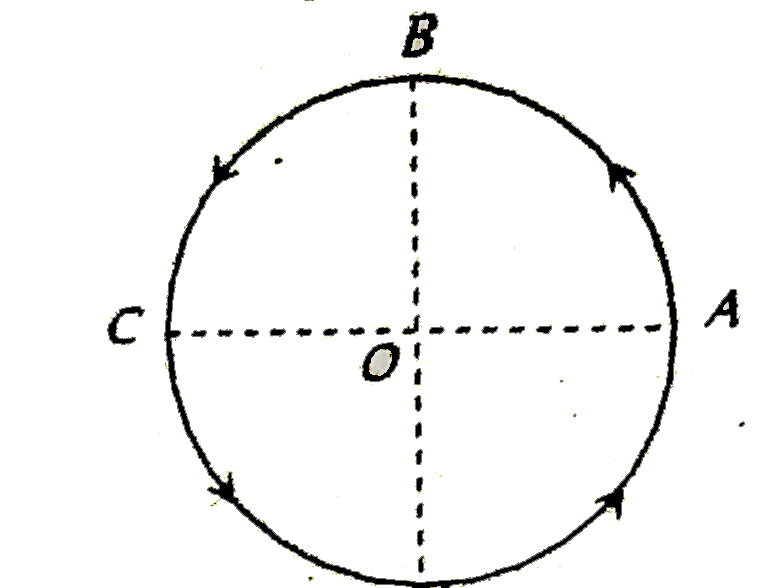A particle of mass m and charge -q is moving with a uniform speed v in a circle of radius r, with another charge q at the centre of the circle. The value of r is:
To find the value of the radius r for a particle of mass m and charge −q moving in a circle of radius r with another charge q at the center, we can follow these steps:
Step 1: Understand the Forces Acting on the Particle
The particle with charge −q experiences a centripetal force due to the electrostatic attraction towards the charge q at the center of the circle. This centripetal force is necessary for the particle to maintain its circular motion.
Step 2: Write the Expression for Electrostatic Force
The electrostatic force F between the two charges can be expressed using Coulomb's law:
F=k⋅|q⋅(−q)|r2=k⋅q2r2
where k is Coulomb's constant, given by k=14πϵ0.
Step 3: Write the Expression for Centripetal Force
The centripetal force Fc required to keep the particle moving in a circle is given by:
Fc=mv2r
Step 4: Set the Forces Equal
Since the electrostatic force provides the necessary centripetal force, we can set these two expressions equal to each other:
k⋅q2r2=mv2r
Step 5: Rearrange the Equation
To find r, we can rearrange the equation:
k⋅q2=mv2⋅r
r=k⋅q2mv2
Step 6: Substitute the Value of k
Now substitute k=14πϵ0 into the equation:
r=14πϵ0⋅q2mv2
r=q24πϵ0mv2
Final Answer
Thus, the value of r is:
r=q24πϵ0mv2
The particle with charge −q experiences a centripetal force due to the electrostatic attraction towards the charge q at the center of the circle. This centripetal force is necessary for the particle to maintain its circular motion.
The electrostatic force F between the two charges can be expressed using Coulomb's law:
F=k⋅|q⋅(−q)|r2=k⋅q2r2
where k is Coulomb's constant, given by k=14πϵ0.
The centripetal force Fc required to keep the particle moving in a circle is given by:
Fc=mv2r
Since the electrostatic force provides the necessary centripetal force, we can set these two expressions equal to each other:
k⋅q2r2=mv2r
To find r, we can rearrange the equation:
k⋅q2=mv2⋅r
r=k⋅q2mv2
Now substitute k=14πϵ0 into the equation:
r=14πϵ0⋅q2mv2
r=q24πϵ0mv2
Thus, the value of r is:
r=q24πϵ0mv2
Topper's Solved these Questions
Similar Questions
A particle having charge + q is fixed at a point O and a second particle of mass m and having charge −q0 moves with constant speed in a circle of radius r about the charge +q. the energy required to be supplied to the moving charge to increase radius of the path to 2r is qq0nπε0r. Find the value of n.
View SolutionThe work done in carrying a charge q once round a circle of radius r with a charge Q at the centre is
View Solution
Knowledge Check
A charged particle of mass m is moving with a speed u in a circle of radius r. If the magnetic field induction at the centre is B, the charge on the particle is
A4πr2Bμ0uB2πr2Bμ0uCmuBrD2muBrA particle is moving with a uniform speed v in a circular path of radius r with the centre at 0. When the particle moves from a point P to Q on the circle such that ∠POQ=θ , then the magnitude of the change in velocity is
A2vsin(2θ)BzeroC2vsin(θ)2D2vcosθ(θ2)A unit positive charge is moved along the circumfer-ence of a circle of radius, r with a −5μC charge at the centre at the centre of the circle. Then, the work done in the process is ______.
Anegative work of 100JBpositive work of 100JCzeroDQ.14π∈0.r
If a charge q is moving in a circle of radius r with speed v, then the equivalent current will be :
View SolutionA particle of mass m and charge -q moves diametrically through a uniformily charged sphere of radius R with total charge Q. The angular frequency of the particle's simple harminic motion, if its amplitude lt R, is given by
View SolutionFigure shows a body of mass m moving with a uniform speed v along a circle of radius r . The change in velocity in going from A to B is

View SolutionThe work done in carrying a charge q once around a circle of radius r with a charge Q placed at the centre centre will be
View SolutionThe work done in carrying a charge q once around a circle of radius r with a charge Q placed at the centre centre will be
View Solution
